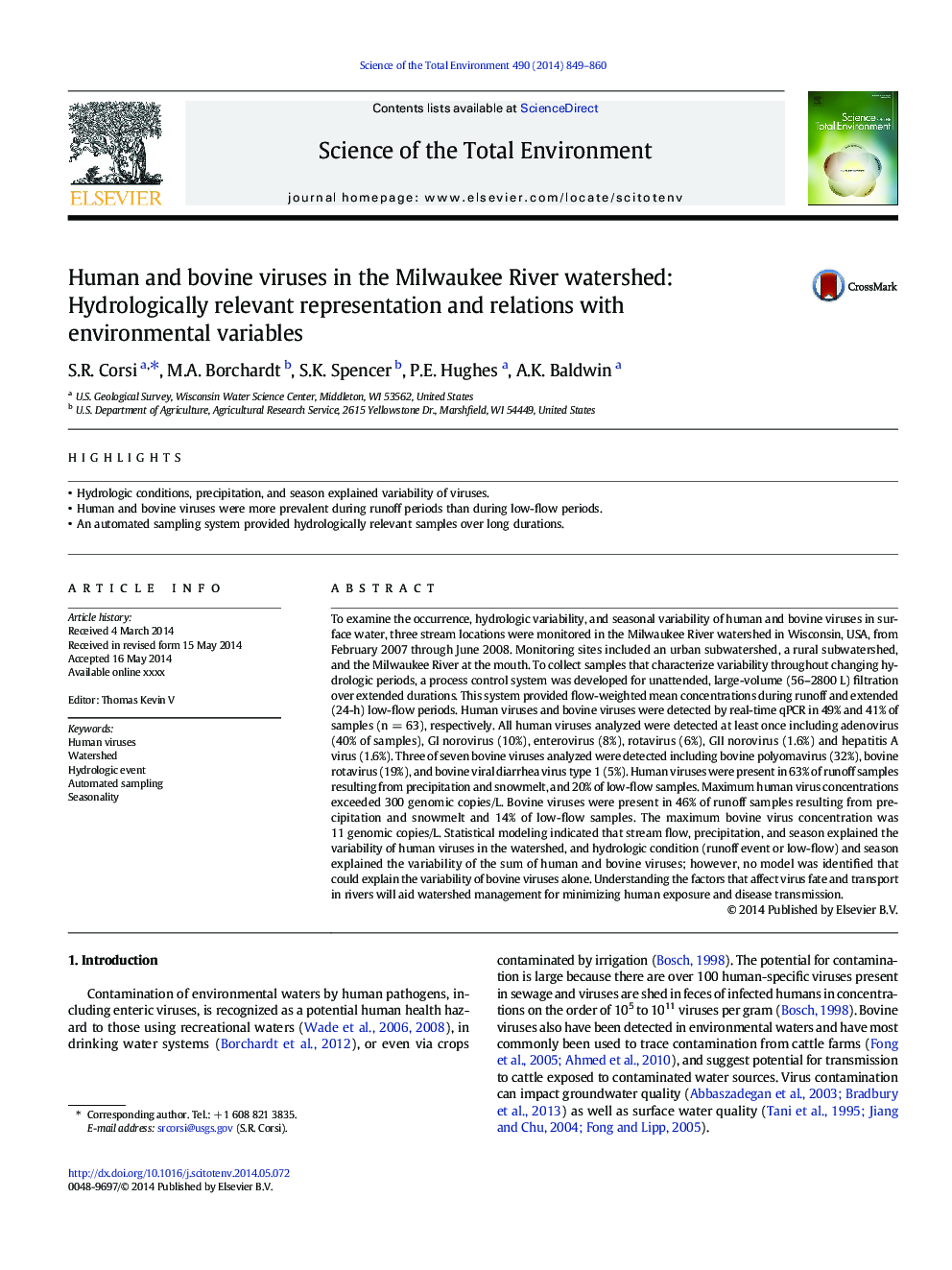| کد مقاله | کد نشریه | سال انتشار | مقاله انگلیسی | نسخه تمام متن |
|---|---|---|---|---|
| 6329286 | 1619780 | 2014 | 12 صفحه PDF | دانلود رایگان |
عنوان انگلیسی مقاله ISI
Human and bovine viruses in the Milwaukee River watershed: Hydrologically relevant representation and relations with environmental variables
ترجمه فارسی عنوان
ویروس های انسانی و گاو در حوزه آبریز رودخانه میلواکی: نمایندگی مرتبط با هیدرولوژیکی و روابط با متغیرهای محیطی
دانلود مقاله + سفارش ترجمه
دانلود مقاله ISI انگلیسی
رایگان برای ایرانیان
کلمات کلیدی
ویروس های انسانی، حوزه آبریز، رویداد هیدرولوژیکی، نمونه گیری خودکار فصلی،
موضوعات مرتبط
علوم زیستی و بیوفناوری
علوم محیط زیست
شیمی زیست محیطی
چکیده انگلیسی
To examine the occurrence, hydrologic variability, and seasonal variability of human and bovine viruses in surface water, three stream locations were monitored in the Milwaukee River watershed in Wisconsin, USA, from February 2007 through June 2008. Monitoring sites included an urban subwatershed, a rural subwatershed, and the Milwaukee River at the mouth. To collect samples that characterize variability throughout changing hydrologic periods, a process control system was developed for unattended, large-volume (56-2800 L) filtration over extended durations. This system provided flow-weighted mean concentrations during runoff and extended (24-h) low-flow periods. Human viruses and bovine viruses were detected by real-time qPCR in 49% and 41% of samples (n = 63), respectively. All human viruses analyzed were detected at least once including adenovirus (40% of samples), GI norovirus (10%), enterovirus (8%), rotavirus (6%), GII norovirus (1.6%) and hepatitis A virus (1.6%). Three of seven bovine viruses analyzed were detected including bovine polyomavirus (32%), bovine rotavirus (19%), and bovine viral diarrhea virus type 1 (5%). Human viruses were present in 63% of runoff samples resulting from precipitation and snowmelt, and 20% of low-flow samples. Maximum human virus concentrations exceeded 300 genomic copies/L. Bovine viruses were present in 46% of runoff samples resulting from precipitation and snowmelt and 14% of low-flow samples. The maximum bovine virus concentration was 11 genomic copies/L. Statistical modeling indicated that stream flow, precipitation, and season explained the variability of human viruses in the watershed, and hydrologic condition (runoff event or low-flow) and season explained the variability of the sum of human and bovine viruses; however, no model was identified that could explain the variability of bovine viruses alone. Understanding the factors that affect virus fate and transport in rivers will aid watershed management for minimizing human exposure and disease transmission.
ناشر
Database: Elsevier - ScienceDirect (ساینس دایرکت)
Journal: Science of The Total Environment - Volume 490, 15 August 2014, Pages 849-860
Journal: Science of The Total Environment - Volume 490, 15 August 2014, Pages 849-860
نویسندگان
S.R. Corsi, M.A. Borchardt, S.K. Spencer, P.E. Hughes, A.K. Baldwin,
